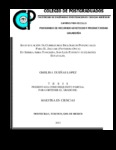| dc.contributor.author | Dueñas López, Gmelina | |
| dc.creator | DUEÑAS LOPEZ, GMELINA; 384503 | |
| dc.date.accessioned | 2013-09-03T21:37:50Z | |
| dc.date.available | 2013-09-03T21:37:50Z | |
| dc.date.issued | 2013 | |
| dc.identifier.uri | http://hdl.handle.net/10521/2030 | |
| dc.description | Tesis (Maestría en Ciencias, especialista en Ganadería).- Colegio de Postgraduados, 2013. | en_US |
| dc.description.abstract | Los jaguares (Panthera onca) debido a sus amplios ámbitos hogareños son susceptibles a los efectos de la fragmentación. Para disminuir tales efectos, los corredores biológicos han sido propuestos como una herramienta para conectar poblaciones aisladas. La Sierra Madre Oriental (SMO) es una unidad de conservación para los jaguares que se considera con baja probabilidad de sostener poblaciones. Se identificaron corredores biológicos potenciales para el jaguar dentro de la SMO, por medio de técnicas de reconocimiento espacial. Mediante el algoritmo Maxent se identificaron parches de hábitat potencial, y a partir del Proceso Jerárquico Analítico y la Combinación Lineal Ponderada se generó una matriz de resistencia. El modelo con los corredores potencialmente viables para el desplazamiento del jaguar en la zona se obtuvo con el algoritmo Rutas de Menor Costo. Se identificaron 581 parches con hábitat potencial altamente adecuado para el jaguar. Donde tres de estos son mayores a 100km2, y son considerados de tipo fundamental. La matriz de resistencia se compone en 3% de zonas con bajo costo, 49% de zonas con costo medio y 48% de zonas con alto costo. El estado de Hidalgo presenta el mayor número de parches tipo “stepping-stone”.El análisis de las rutas de menor costo mostró la existencia de corredores significativos que inician en el sur de San Luis Potosí y llegan al norte de Puebla. Es probable que la SMO no esté aislada del resto de la distribución del jaguar. _______________ IDENTIFICATION OF BIOLOGICAL CORRIDORS FOR JAGUARS (Panthera onca), IN THE ABRA TANCHIPA, SAN LUIS POTOSI AND LIMITS STATE. ABSTRACT: The Jaguar (Panthera onca) due to its large home range is susceptible to the effects of fragmentation. To reduce these effects, biological corridors have been proposed as a tool to connect isolated populations. The Sierra Madre Oriental (SMO) is a unit for conservation of jaguar populations. Through spatial recognition techniques, we identified potential corridors for Jaguars in the SMO,. Habitat patches were located by the Maxent algorithm. Then, a resistance matrix was generated using the Analytical Hierarchy Process and a weighted linear combination. The model with potentially viable corridors for jaguar movement in the area was obtained with the lowest cost routes algorithm. We identified 581 potential highly suitable habitat patches for the Jaguar. Of these, 3 were > 100 km2 and thus met the criteria for fundamental patches. The resistance matrix consists of 3% of low cost areas, as well as 49% and 48% of intermediate and high cost areas. We found the majority of stepping-stone type patches in Hidalgo. The analysis of the least cost path showed the existence of a main corridor that starts in southern San Luis Potosi and reaches the northern portion of Puebla. SMO is likely not isolated from the rest of the distributional range of the jaguar. | en_US |
| dc.description.sponsorship | Consejo Nacional de Ciencia y Tecnología (CONACYT). | en_US |
| dc.language.iso | spa | en_US |
| dc.rights.uri | http://creativecommons.org/licenses/by-nc-nd/4.0 | |
| dc.subject | Dispersión | en_US |
| dc.subject | SIG | en_US |
| dc.subject | Rutas de menor costo | en_US |
| dc.subject | Stepping-stone | en_US |
| dc.subject | Dispersion | en_US |
| dc.subject | GIS | en_US |
| dc.subject | Least cost path | en_US |
| dc.subject | Ganadería | en_US |
| dc.subject | Maestría | en_US |
| dc.title | Identificación de corredores biológicos potenciales para el jaguar (Panthera Onca) en Sierra Abra Tanchipa, San Luis Potosí y sus límites estatales | en_US |
| dc.type | Tesis | en_US |
| Tesis.contributor.advisor | Rosas Rosas, Octavio César | |
| Tesis.contributor.advisor | Chapa Vargas, Leonardo | |
| Tesis.contributor.advisor | Martínez Montoya, Juan Felipe | |
| Tesis.contributor.advisor | Alcántara Carbajal, José Luis | |
| Tesis.contributor.advisor | Tarango Arámbula, Luis Antonio | |
| Tesis.date.submitted | 2013 | |
| Tesis.date.accesioned | 2013-08-23 | |
| Tesis.date.available | 2013-09-03 | |
| Tesis.format.mimetype | pdf | en_US |
| Tesis.format.extent | 1,849 KB | en_US |
| Tesis.subject.nal | Panthera onca | en_US |
| Tesis.subject.nal | Corredores biológicos | en_US |
| Tesis.subject.nal | Biological corridors | en_US |
| Tesis.subject.nal | Variación genética | en_US |
| Tesis.subject.nal | Genetic variation | en_US |
| Tesis.subject.nal | Fragmentación de hábitats | en_US |
| Tesis.subject.nal | Habitat fragmentation | en_US |
| Tesis.subject.nal | Conservación del hábitat | en_US |
| Tesis.subject.nal | Habitat conservation | en_US |
| Tesis.subject.nal | Manejo de vida silvestre | en_US |
| Tesis.subject.nal | Wildlife management | en_US |
| Tesis.subject.nal | San Luis Potosí, México | en_US |
| Articulos.subject.classification | Jaguares | en_US |
| dc.type.conacyt | masterThesis | |
| dc.identificator | 6 | |
| dc.contributor.director | ROSAS ROSAS, OCTAVIO CESAR; 201123 | |


